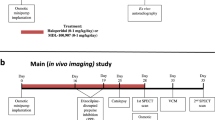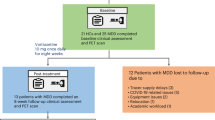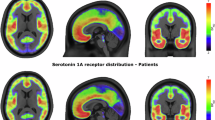Abstract
Previous reports have demonstrated the anxiolytic effect of the potent and systemically active metabotropic glutamate subtype 5 (mGlu5) receptor antagonist 2-methyl-6-(phenylethynyl)pyridine (MPEP) in rodents. Here, we present evidence for the anxiolytic activity of a novel mGlu5 receptor antagonist, 3-[(2-methyl-1,3-thiazol-4-yl)ethynyl]pyridine (MTEP), in rats and compare its profile to the benzodiazepine receptor agonist diazepam. MTEP occupied mGlu5 receptors in a dose-dependent manner with essentially full receptor occupancy at the highest dose tested (10 mg/kg, i.p.). At doses appropriate for mGlu5 receptor-mediated effects, MTEP significantly reduced fear-potentiated startle and increased punished responding in a modified Geller–Seifter conflict model consistent with an anxiolytic-like profile. In both models, the magnitude of the anxiolytic-like response was similar to that seen with diazepam. In contrast, MTEP decreased unpunished responding to a lesser extent than diazepam and had no effect on rotarod performance when administered either alone or in combination with ethanol. Repeated dosing with MTEP in this model eliminated the increase in punished responding observed with acute dosing. The present results suggest that mGlu5 receptor antagonists lack the side effects seen with benzodiazepines, such as sedation and ethanol interaction, and provide insight into a possible role for mGlu5 receptor antagonists in the modulation of mood disorders.
Similar content being viewed by others
Log in or create a free account to read this content
Gain free access to this article, as well as selected content from this journal and more on nature.com
or
References
Anderson JJ, Bradbury MJ, Giracello DR, Chapman DF, Holtz G, Roppe J et al (2003). In vivo receptor occupancy of mGlu5 receptor antagonists using the novel radioligand [3H]3-methoxy-5-(pyridin-2-ylethynyl)pyridine). Eur J Pharmacol 473: 35–40.
Anderson JJ, Rao SP, Rowe B, Giracello DR, Holtz G, Chapman DF et al (2002). [3H]Methoxymethyl-3-[(2-methyl-1,3-thiazol-4-yl)ethynyl]pyridine binding to metabotropic glutamate receptor subtype 5 in rodent brain: in vitro and in vivo characterization. J Pharmacol Exp Ther 303: 1044–1051.
Argyropoulos SP, Sandford JJ, Nutt DJ (2000). The psychobiology of anxiolytic drugs. Part 2. Pharmacological treatments of anxiety. Pharmacol Ther 88: 213–227.
Baude A, Nusser Z, Roberts JD, Mulvihill E, McIlhinney RA, Somogyi P (1993). The metabotropic glutamate receptor (mGluR1 alpha) is concentrated at perisynaptic membrane of neuronal subpopulations as detected by immunogold reaction. Neuron 11: 771–787.
Breysse N, Baunez C, Spooren W, Gasparini F, Amalric M (2002). Chronic but not acute treatment with a metabotropic glutamate 5 receptor antagonist reverses the akinetic deficits in a rat model of parkinsonism. J Neurosci 22: 5669–5678.
Brodkin J, Bradbury M, Busse C, Warren N, Bristow LJ, Varney MA (2002b). Reduced stress-induced hyperthermia in mGluR5 knockout mice. Eur J Neurosci 16: 2241–2244.
Brodkin J, Busse C, Sukoff SJ, Varney MA (2002a). Anxiolytic-like activity of the mGluR5 antagonist MPEP: a comparison with diazepam and buspirone. Pharmacol Biochem Behav 73: 359–366.
Cervo L, Munoz C, Bertaglia A, Samanin R (2000). Alnespirone and buspirone have anxiolytic-like effects in a conflict procedure in rats by stimulating 5-HT(1A) receptors. Behav Pharmacol 11: 153–160.
Conn PJ, Pin JP (1997). Pharmacology and functions of metabotropic glutamate receptors. Annu Rev Pharmacol Toxicol 37: 205–237.
Cosford ND, Roppe J, Tehrani L, Schweiger EJ, Seiders TJ, Chaudary A et al (2003a). [3H]-Methoxymethyl-MTEP and [3H]-methoxy-PEPy: potent and selective radioligands for the metabotropic glutamate subtype 5 (mGlu5) receptor. Bioorg Med Chem Lett 13: 351–354.
Cosford ND, Tehrani L, Roppe J, Schweiger E, Smith ND, Anderson J et al (2003b). 3-[(2-Methyl-1,3-thiazol-4-yl)ethynyl]-pyridine: a potent and highly selective metabotropic glutamate subtype 5 receptor antagonist with anxiolytic activity. J Med Chem 46: 204–206.
Davidson JRT, DuPont RL, Hedges D, Haskins JT (1999). Efficacy, safety, and tolerability of venlafaxine extended release and buspirone in outpatients with generalized anxiety disorder. J Clin Psychiatry 60: 528–535.
Davis M (1979). Diazepam and flurazepam: effects on conditioned fear as measured with the potentiated startle paradigm. Psychopharmacology 62: 1–7.
Davis M, Falls WA, Campeau S, Kim M (1993). Fear-potentiated startle: a neural and pharmacological analysis. Behav Brain Res 58: 175–198.
DuPont RL, Rice DP, Miller LS, Shiraki SS, Rowland CR, Harwood HJ (1996). Economic costs of anxiety disorders. Anxiety 2: 167–172.
Gasparini F, Lingenhohl K, Stoehr N, Flor PJ, Heinrich M, Vranesic I et al (1999). 2-Methyl-6-(phenylethynyl)-pyridine (MPEP), a potent, selective systemically active mGluR5 receptor antagonist. Neuropharmacology 38: 1493–1503.
Hascoët M, Bourin M (1997). Anitconflict effect of alpidem as compared with the benzodiazepine alprazolam in rats. Pharmacol Biochem Behav 56: 317–324.
Hu WY, Reiffenstein RJ, Wong L (1987). Interaction between flurazepam and ethanol. Alcohol Drug Res 7: 107–117.
Ikeda SR, Lovinger DM, McCool BA, Lewis DL (1995). Heterologous expression of metabotropic glutamate receptors in adult rat sympathetic neurons: subtype-specific coupling to ion channels. Neuron 14: 1029–1038.
Levy M, Jing J, Chikvashvili D, Thornhill WB, Lotan I (1998). Activation of a metabotropic glutamate receptor and protein kinase C reduce the extent of inactivation of the K+ channel Kv1.1/Kvbeta1.1 via dephosphorylation of Kv1.1. J Biol Chem 273: 6495–6502.
Lydiard RB (2000). An overview of generalized anxiety disorder: disease state-appropriate therapy. Clin Ther 22: A3–A19.
Lydiard RB, Brawman-Mintzer O, Ballenger JC (1996). Recent developments in the psychopharmacology of anxiety disorders. J Consult Clin Psychol 64: 660–668.
Maickel RP, Nash Jr JF (1986). Drug interactions with ethanol. Effects on body temperature and motor impairment. Neuropharmacology 25: 315–322.
Mathiesen JM, Svendsen N, Brauner-Osborne H, Thomsen C, Ramirez MT (2003). Positive allosteric modulation of the human metabotropic glutamate receptor 4 (hmGluR4) by SIB-1893 and MPEP. Br J Pharmacol 138: 1026–1030.
McCool BA, Pin JP, Harpold MM, Brust PF, Stauderman KA, Lovinger DM (1998). Rat group I metabotropic glutamate receptors inhibit neuronal Ca2+ channels via multiple signal transduction pathways in HEK 293 cells. J Neurophysiol 79: 379–391.
Petralia RS, Wang YX, Niedzielski AS, Wenthold RJ (1996). The metabotropic glutamate receptors, mGluR2 and mGluR3, show unique postsynaptic, presynaptic and glial localizations. Neuroscience 71: 949–976.
Pilc A, Kłodziñska A, Brañski P, Nowak G, Pałucha A, Szewczyk B et al (2002). Multiple MPEP administrations evoke anxiolytic- and antidepressant-like effects in rats. Neuropharmacology 43: 181–187.
Rakel RE (1990). Long-term buspirone therapy for chronic anxiety: a multicenter international study to determine safety. South Med J 83: 194–198.
Romano C, Sesma MA, McDonald CT, O'Malley K, Van den Pol AN, Olney JW (1995). Distribution of metabotropic glutamate receptor mGluR5 immunoreactivity in rat brain. J Comp Neurol 355: 455–469.
Roppe J, Smith ND, Huang D, Tehrani L, Wang B, Anderson J et al (in press). The discovery of novel heteroaryl azoles that are metabotropic glutamate subtype 5 (mGlu5) receptor antagonists with anxiolytic activity. J Med Chem.
Schulz B, Fendt M, Gasparini F, Lingenhöhl K, Kuhn R, Koch M (2001). The metabotropic glutamate receptor antagonist 2-methyl-6-(phenylethynyl)-pyridine (MPEP) blocks fear conditioning in rats. Neuropharmacology 41: 1–7.
Shader RI, Greenblatt DJ (1993). Use of benzodiazepines in anxiety disorders. N Engl J Med 328: 1398–1405.
Shigemoto R, Kinoshita A, Wada E, Nomura S, Ohishi H, Takada M et al (1997). Differential presynaptic localization of metabotropic glutamate receptor subtypes in the rat hippocampus. J Neurosci 17: 7503–7522.
Shigemoto R, Nomura S, Ohishi H, Sugihara H, Nakanishi S, Mizuno N (1993). Immunohistochemical localization of a metabotropic glutamate receptor, mGluR5, in the rat brain. Neurosci Lett 163: 53–57.
Spooren WPJM, Schoeffter P, Gasparini F, Kuhn R, Gentsch C (2002). Pharmacological and endocrinological characterisation of stress-induced hyperthermia in singly housed mice using classical and candidate anxiolytics (LY314582, MPEP and NKP608). Eur J Pharmacol 435: 161–170.
Spooren WPJM, Vassout A, Neijt HC, Kuhn R, Gasparini F, Roux S et al (2000). Anxiolytic-like effects of the prototypical metabotropic glutamate receptor 5 antagonist 2-methyl-6-(phenylethynyl)pyridine in rodents. J Pharmacol Exp Ther 295: 1267–1275.
Takahashi T, Forsythe ID, Tsujimoto T, Barnes-Davies M, Onodera K (1996). Presynaptic calcium current modulation by a metabotropic glutamate receptor. Science 274: 594–597.
Tatarczynska E, Klodzinska A, Chojnacka-Wojcik E, Palucha A, Gasparini F, Kuhn R et al (2001). Potential anxiolytic- and antidepressant-like effects of MPEP, a potent, selective and systemically active mGlu5 receptor antagonist. Br J Pharmacol 132: 1423–1430.
Varney MA, Cosford NDP, Jachec C, Rao SP, Sacaan A, Lin F-F et al (1999). SIB-1757 and SIB-1893: selective, non-competitive antagonists of metabotropic glutamate receptor type 5 (mGluR5). J Pharmacol Exp Ther 290: 170–181.
Volke V, Soosaar A, Kõks S, Vasar E, Männistö PT (1998). L-Argininine abolishes the anxiolytic-like effect of diazepam in the elevated plus maze in rats. Eur J Pharmacol 351: 287–290.
Yasumatsu H, Morimoto Y, Yamamoto Y, Takehara S, Fukuda T, Nakao T et al (1994). The pharmacological properties of Y-23684, a benzodiazepine receptor partial agonist. Br J Pharmacol 111: 1170–1180.
Zhou FM, Hablitz JJ (1997). Metabotropic glutamate receptor enhancement of spontaneous IPSCs in neocortical interneurons. J Neurophysiol 78: 2287–2295.
Author information
Authors and Affiliations
Corresponding author
Rights and permissions
About this article
Cite this article
Busse, C., Brodkin, J., Tattersall, D. et al. The Behavioral Profile of the Potent and Selective mGlu5 Receptor Antagonist 3-[(2-methyl-1,3-thiazol-4-yl)ethynyl]pyridine (MTEP) in Rodent Models of Anxiety. Neuropsychopharmacol 29, 1971–1979 (2004). https://doi.org/10.1038/sj.npp.1300540
Received:
Revised:
Accepted:
Published:
Issue date:
DOI: https://doi.org/10.1038/sj.npp.1300540
Keywords
This article is cited by
-
Pharmacological modulation of conditioned fear in the fear-potentiated startle test: a systematic review and meta-analysis of animal studies
Psychopharmacology (2023)
-
Physiological activation of mGlu5 receptors supports the ion channel function of NMDA receptors in hippocampal LTD induction in vivo
Scientific Reports (2018)
-
Social Isolation During Adolescence Induces Anxiety Behaviors and Enhances Firing Activity in BLA Pyramidal Neurons via mGluR5 Upregulation
Molecular Neurobiology (2018)
-
Partial mGlu5 Negative Allosteric Modulators Attenuate Cocaine-Mediated Behaviors and Lack Psychotomimetic-Like Effects
Neuropsychopharmacology (2016)
-
Dissociable effects of mGluR5 allosteric modulation on distinct forms of impulsivity in rats: interaction with NMDA receptor antagonism
Psychopharmacology (2015)



